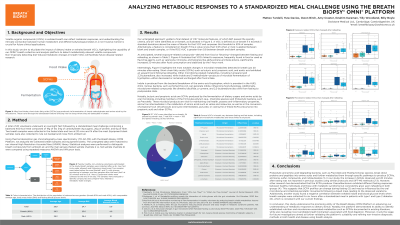Tuesday Poster Session
Category: Colon
P3670 - Analyzing Metabolic Responses to a Standardized Meal Challenge Using Exhaled Breath
Tuesday, October 29, 2024
10:30 AM - 4:00 PM ET
Location: Exhibit Hall E

Has Audio

Huw Davies, PhD
Owlstone Medical
Cambridge, England, United Kingdom
Presenting Author(s)
Huw Davies, PhD, Lara Pocock, MSc, BSc, Matteo Tardelli, PhD, Amy Craster, , Ibrahim Karaman, , Tilly Woodland, , Billy Boyle, MS
Owlstone Medical, Cambridge, England, United Kingdom
Introduction: Volatile organic compounds (VOCs) in exhaled breath can reflect metabolic responses, and understanding the intricate connection between human metabolism and different physiological states in a non-invasive manner is crucial for future clinical applications. In this study, we aimed to elucidate the impact of dietary intake on exhaled breath VOCs, demonstrating the capability of breath collection and analysis to detect metabolically relevant volatile compounds. Non-invasively detecting diet-induced metabolic changes in breath VOCs will facilitate future disease-related research.
Methods: 20 volunteers underwent an overnight fast followed by a standardized meal challenge, consisting of a balanced 400 kcal meal with 19g of fat, 34g of carbohydrates (4g sugars), 20g of protein, and 6g of fiber. Two breath samples were collected in the fasted state and two at 20 minutes and 1 hour post-meal. Blank samples were also collected to rule out background noise. Using thermal desorption gas chromatography-mass spectrometry (TD-GC-MS), we analyzed the collected breath samples. The untargeted data were then matched to our internal High-Resolution Accurate Mass (HRAM) library.
Results: Several microbiome-related and exposure compounds (deriving from food or flavoring) changed from fasting to refeeding. Short-chain fatty acids such as butyric acid, propionic acid, and acetic acid showed an upward trend following refeeding. Other microbiome-related metabolites, such as 1-propanol and 2,3-butanedione, also increased, while indole and 3-methylindole, products of microbial fermentation of tryptophan, decreased or remained unchanged after food intake. Additionally, other VOCs linked to exposure, commonly found in food or used as flavoring agents, such as valencene, limonene, and terpenes such as alpha-pinene and beta-pinene, significantly increased 20 minutes after food consumption and stabilized at the 1-hour timepoint.
Discussion: This study underscores the utility of breath analysis in advancing our understanding of metabolic responses to dietary stimuli. The platform effectively identified established nutrition and microbiome-associated metabolites documented in existing literature, while also revealing novel candidate breath biomarkers. Moreover, it sets the stage for future investigations aimed at further validating the platform's suitability and refining non-invasive diagnostic methods in both health and disease using breath analysis.
Disclosures:
Huw Davies, PhD, Lara Pocock, MSc, BSc, Matteo Tardelli, PhD, Amy Craster, , Ibrahim Karaman, , Tilly Woodland, , Billy Boyle, MS. P3670 - Analyzing Metabolic Responses to a Standardized Meal Challenge Using Exhaled Breath, ACG 2024 Annual Scientific Meeting Abstracts. Philadelphia, PA: American College of Gastroenterology.
Owlstone Medical, Cambridge, England, United Kingdom
Introduction: Volatile organic compounds (VOCs) in exhaled breath can reflect metabolic responses, and understanding the intricate connection between human metabolism and different physiological states in a non-invasive manner is crucial for future clinical applications. In this study, we aimed to elucidate the impact of dietary intake on exhaled breath VOCs, demonstrating the capability of breath collection and analysis to detect metabolically relevant volatile compounds. Non-invasively detecting diet-induced metabolic changes in breath VOCs will facilitate future disease-related research.
Methods: 20 volunteers underwent an overnight fast followed by a standardized meal challenge, consisting of a balanced 400 kcal meal with 19g of fat, 34g of carbohydrates (4g sugars), 20g of protein, and 6g of fiber. Two breath samples were collected in the fasted state and two at 20 minutes and 1 hour post-meal. Blank samples were also collected to rule out background noise. Using thermal desorption gas chromatography-mass spectrometry (TD-GC-MS), we analyzed the collected breath samples. The untargeted data were then matched to our internal High-Resolution Accurate Mass (HRAM) library.
Results: Several microbiome-related and exposure compounds (deriving from food or flavoring) changed from fasting to refeeding. Short-chain fatty acids such as butyric acid, propionic acid, and acetic acid showed an upward trend following refeeding. Other microbiome-related metabolites, such as 1-propanol and 2,3-butanedione, also increased, while indole and 3-methylindole, products of microbial fermentation of tryptophan, decreased or remained unchanged after food intake. Additionally, other VOCs linked to exposure, commonly found in food or used as flavoring agents, such as valencene, limonene, and terpenes such as alpha-pinene and beta-pinene, significantly increased 20 minutes after food consumption and stabilized at the 1-hour timepoint.
Discussion: This study underscores the utility of breath analysis in advancing our understanding of metabolic responses to dietary stimuli. The platform effectively identified established nutrition and microbiome-associated metabolites documented in existing literature, while also revealing novel candidate breath biomarkers. Moreover, it sets the stage for future investigations aimed at further validating the platform's suitability and refining non-invasive diagnostic methods in both health and disease using breath analysis.
Disclosures:
Huw Davies indicated no relevant financial relationships.
Lara Pocock indicated no relevant financial relationships.
Matteo Tardelli: Owlstone Medical – Employee.
Amy Craster: Owlstone Medical – Employee.
Ibrahim Karaman: Owlstone Medical – Employee.
Tilly Woodland: Owlstone Medical – Employee.
Billy Boyle indicated no relevant financial relationships.
Huw Davies, PhD, Lara Pocock, MSc, BSc, Matteo Tardelli, PhD, Amy Craster, , Ibrahim Karaman, , Tilly Woodland, , Billy Boyle, MS. P3670 - Analyzing Metabolic Responses to a Standardized Meal Challenge Using Exhaled Breath, ACG 2024 Annual Scientific Meeting Abstracts. Philadelphia, PA: American College of Gastroenterology.
